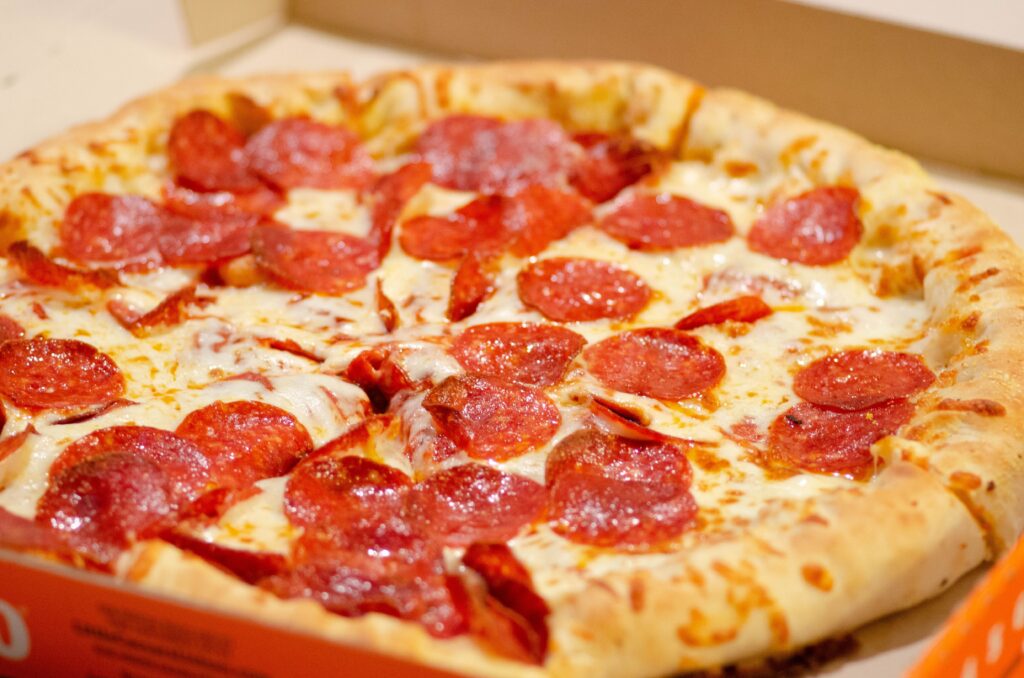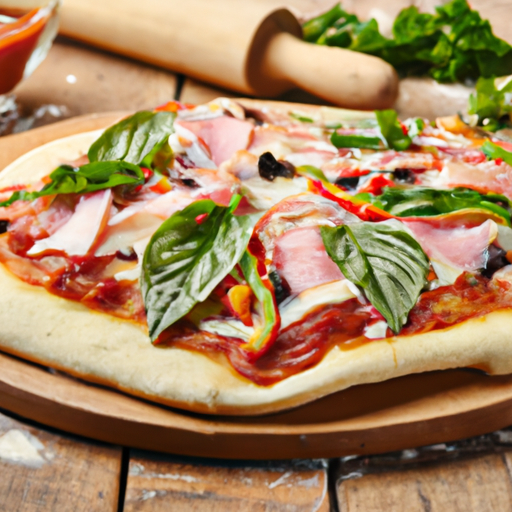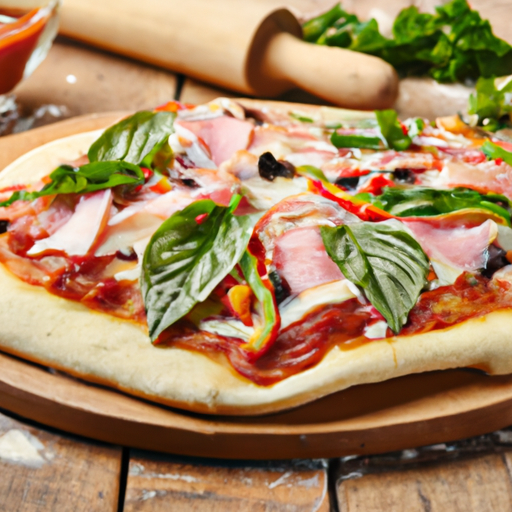In this article, “Crave-Worthy Creations: Thin Pizza Dough Crust Recipe for Delightful Evenings,” you will discover a quick and easy recipe for making the ultimate thin crust pizza. This recipe is perfect for beginners and guarantees a crispy and flavorful crust. The dough ratio is 1 cup of water to 2 cups of flour, with water added in stages to ensure the perfect consistency. After letting the dough rise for an hour, you will bake the pizza in a preheated oven, starting with a cast-iron skillet for that extra crunch. Topped with pizza sauce, mozzarella cheese, mild cheddar, spinach, and oregano, this homemade pizza will rival any takeout or delivery option.
Whether you’re a seasoned pizza maker or a newbie in the kitchen, this recipe will guide you through the process step by step. From making the yeast mixture to kneading the dough to baking it in two stages for that ultimate crunch, you’ll have a mouthwatering thin crust pizza ready in no time. So, put away the pizza delivery menu and give this recipe a try for a delightful and delicious evening at home.

This image is property of images.unsplash.com.
Get the flour to make your thin crust pizza recipe here!
Ingredients for your Thin Pizza Dough Crust Recipe
To make a delicious homemade thin pizza dough crust recipe, you will need the following ingredients:
Pizza dough
The foundation of any good pizza is a well-made dough. You can either make your own pizza dough from scratch or use a pre-made dough from the store. Making your own dough allows for more customization and control over the texture and flavor of your crust.
Pizza sauce
A flavorful sauce is essential to creating a delicious pizza. You can use a store-bought pizza sauce or make your own by blending together tomatoes, garlic, herbs, and spices. Experiment with different flavors and seasonings to find your perfect sauce.
Mozzarella cheese
No pizza is complete without a generous amount of melted mozzarella cheese. This classic cheese provides a creamy and gooey texture that pairs perfectly with the other toppings. Opt for fresh mozzarella if available for a truly authentic taste and texture.
Mild cheddar
Adding a bit of mild cheddar cheese to your pizza can add a subtle tang and depth of flavor. It complements the mozzarella well and provides a slight sharpness to the overall taste.
Spinach
Adding some fresh spinach to your pizza not only adds a vibrant green color but also provides a healthy and nutritious element. Spinach pairs well with cheese and sauce, and its slight bitterness balances out the richness of the other ingredients.
Oregano
A sprinkle of dried oregano adds a dash of herbal flavor to your pizza. It complements the other ingredients and adds a subtle aroma.
Preparing the Pizza Dough
Before you can start baking your thin crust pizza, you need to prepare the dough. Follow these steps for a perfect dough:
Mixing the flour and yeast
In a mixing bowl, combine the desired amount of flour with yeast. The yeast helps the dough rise and gives it a light and airy texture. Ensure that the yeast is evenly distributed throughout the flour.
Adding water in stages
Slowly add water to the flour mixture, stirring constantly. Add the water in stages to avoid making the dough too wet. The amount of water needed can vary depending on the specific recipe, so it’s best to follow the instructions provided.
Kneading the dough
Transfer the dough to a lightly floured surface and begin kneading. Knead the dough for about 5-7 minutes, or until it becomes smooth and elastic. This helps develop the gluten in the dough, which gives it structure and elasticity.
Letting the dough rise
Place the kneaded dough in a greased bowl and cover it with a clean kitchen towel or plastic wrap. Allow the dough to rise in a warm area for about 1-2 hours, or until it has doubled in size. The warmth helps activate the yeast and allows the dough to rise properly, giving it a light and fluffy consistency.
Get the flour to make your thin crust pizza recipe here!
Baking the Thin Crust Pizza
Once the dough is ready, it’s time to bake your thin crust pizza. Follow these steps:
Preheating the oven
Preheat your oven to the recommended temperature stated in your recipe. Preheating ensures that the oven is at the optimal temperature for baking the pizza, resulting in a crispy and evenly cooked crust.
Heating the cast-iron skillet
Place a cast-iron skillet in the preheated oven for about 10 minutes. Heating the skillet before baking the pizza helps create a crispy and golden crust on the bottom.
Baking the dough for 4 minutes
Remove the heated cast-iron skillet from the oven and carefully transfer the rolled-out pizza dough onto the skillet. Place it back in the oven and bake the dough for about 4 minutes. This initial baking allows the crust to firm up slightly before adding the toppings.
Adding sauce and toppings
After the initial baking, remove the partially cooked dough from the oven and spread the pizza sauce evenly over the surface. Be sure to leave a small border around the edges for the crust. Then, sprinkle a generous amount of mozzarella cheese and mild cheddar on top, followed by a layer of fresh spinach leaves. Finish it off with a sprinkle of oregano for added flavor.
Baking for another 8 minutes
Return the pizza to the oven and bake for an additional 8 minutes, or until the cheese is melted and bubbly, and the crust is golden brown. Keep a close eye on the pizza during this time to ensure it doesn’t overcook or burn.
Adding the Toppings
To create a delicious and visually appealing pizza, follow these steps to add the toppings:
Spreading pizza sauce
Using a spoon or ladle, spread a generous amount of pizza sauce over the partially cooked crust. Start from the center and work your way outwards, leaving a small border around the edges for the crust. Be sure to cover the entire surface evenly to ensure a balanced flavor throughout the pizza.
Sprinkling mozzarella cheese
Next, sprinkle a generous amount of mozzarella cheese over the sauce. Opt for freshly grated cheese for better melting and flavor. Spread the cheese evenly to ensure each bite has a gooey and cheesy goodness.
Adding mild cheddar
For an extra layer of flavor, sprinkle some mild cheddar cheese over the mozzarella. This adds a slight tanginess and adds depth to the overall taste of the pizza.
Adding spinach
Spread a handful of fresh spinach leaves over the cheese. Position the leaves evenly, ensuring that each slice will have a good amount of spinach. The spinach will wilt slightly during baking, adding a subtle earthy flavor and vibrant green color to your pizza.
Sprinkling oregano
To enhance the overall flavor of your pizza, sprinkle a pinch of dried oregano over the toppings. Oregano adds an aromatic and herbaceous note that complements the other ingredients. Be careful not to add too much, as oregano can easily overpower the other flavors.

This image is property of images.unsplash.com.
Tips for a Crunchy Crust
If you prefer a crunchy crust for your thin crust pizza, here are some helpful tips to achieve the perfect texture:
Use a hot oven and preheated skillet
Preheat your oven to the highest temperature recommended for the recipe. A hot oven helps create a crisp and golden crust. Additionally, preheating the cast-iron skillet before baking the pizza dough on it ensures that the bottom crust gets a good initial sear.
Roll the dough thin
When rolling out the dough, ensure that it is rolled out thin. A thinner crust will crisp up more easily during baking, creating a crunchier texture. However, be careful not to roll it out too thin, as it may become brittle or burn easily.
Prick the dough with a fork
After rolling out the dough, use a fork to prick the surface all over. This helps release any trapped air bubbles, preventing the crust from rising too much and becoming soft instead of crunchy.
Add toppings sparingly
To avoid a soggy crust, it’s important not to overload the pizza with too many toppings. Use a light hand when adding sauce, cheese, and other toppings. This allows the crust to crisp up properly, resulting in a delightful crunch.
Variations and Customizations
One of the best things about making your own pizza is the opportunity to experiment with different flavors and toppings. Here are some variations and customizations you can try:
Experimenting with different cheeses
While mozzarella is the classic choice for pizza, don’t be afraid to experiment with different cheeses. Try adding some crumbled blue cheese for a tangy and pungent flavor, or use a blend of different cheeses for added complexity. The options are endless, so have fun discovering your favorite cheese combinations.
Adding meat toppings
If you’re a meat lover, add some cooked and thinly sliced meats such as pepperoni, sausage, or bacon. These meats add a savory and salty element to the pizza and complement the cheese and sauce perfectly.
Incorporating vegetables
In addition to spinach, there are plenty of other vegetables that can be added to your pizza. Bell peppers, mushrooms, onions, and tomatoes are popular choices that add texture, flavor, and color to your pizza. Experiment with different combinations to find your preferred vegetable medley.
Using different sauces
While traditional tomato-based pizza sauce is delicious, you can also try using alternative sauces for a unique twist. Pesto, Alfredo sauce, or even barbecue sauce can be used as a base for your pizza. These sauces offer different flavors and can completely transform the overall taste of your pizza.

This image is property of images.unsplash.com.
Serving and Presentation
Once your thin crust pizza is baked to perfection, it’s time to serve and present it beautifully. Follow these steps for an aesthetically pleasing presentation:
Slicing the pizza
Using a pizza cutter or a sharp knife, carefully slice the pizza into equally sized wedges. Start from the center and work your way outward to ensure even slices. A well-sliced pizza not only looks pleasing but also makes it easier for everyone to enjoy.
Plating and garnishing
Transfer the slices onto a serving plate or a wooden pizza board. Arrange them neatly to enhance the visual appeal. If desired, garnish the pizza with a sprinkle of extra cheese, fresh basil leaves, or a drizzle of olive oil to add an extra touch of elegance.
Pairing with beverages
To complete the dining experience, pair your thin crust pizza with your favorite beverages. Opt for a classic pairing such as a cold beer or a refreshing glass of soda. Alternatively, enjoy your pizza with a glass of wine that complements the flavors of your toppings. Remember, the aim is to enhance the overall enjoyment of your meal.
Troubleshooting
Making pizza from scratch can sometimes come with challenges. Here are some common troubleshooting issues and how to overcome them:
Dough too sticky
If your dough turns out too sticky, it may be due to adding too much water or not enough flour. To salvage the dough, gradually add more flour while kneading until it reaches the desired consistency. Adding a small amount of flour to your hands can also help prevent sticking while shaping the dough.
Dough not rising
If your dough fails to rise, it could be due to various factors such as inactive yeast, cold environment, or insufficient time for proofing. Ensure that your yeast is fresh and within the expiration date. Place the dough in a warm and draft-free area to promote proper rising. Give it enough time to double in size before proceeding with the recipe.
Burnt crust
If you notice that your crust is burning too quickly while baking, it may be because the oven temperature is too high. Reduce the temperature slightly and keep a close eye on the pizza during the baking process. You can also move the rack to a lower position in the oven to prevent the top from burning.
Soggy crust
If your crust turns out soggy, it may be due to adding too many wet toppings or not cooking the pizza at a high enough temperature. To prevent a soggy crust, make sure to drain any excess moisture from the toppings before adding them to the pizza. Additionally, bake the pizza at a high temperature to ensure proper evaporation of moisture from the crust.

Storage and Reheating
If you have any leftover pizza, here are some tips for storing and reheating:
Storing leftover dough
If you have leftover pizza dough, you can store it in the refrigerator for up to 3 days. Wrap the dough tightly in plastic wrap or place it in an airtight container to prevent it from drying out. When ready to use, allow the dough to come to room temperature before rolling it out and baking.
Reheating the pizza
To reheat leftover pizza, preheat your oven to 350°F (175°C) and place the slices directly on the oven rack or a baking sheet. Bake for 10-15 minutes, or until the cheese is bubbly and the crust is heated through. For a quicker option, you can also use a microwave, but the crust may become slightly softer.
Conclusion
With the right ingredients and a few simple steps, you can easily create a delicious thin crust pizza in the comfort of your own home. Whether you stick to the classic combination of cheese and sauce or opt for a more adventurous topping selection, making your own pizza allows you to customize it to your personal taste. From preparing the dough to adding the toppings and baking it to perfection, the process is both fun and rewarding. So gather your ingredients, let your creativity flow, and enjoy a slice of homemade pizza that will surely impress your taste buds. Happy baking!
